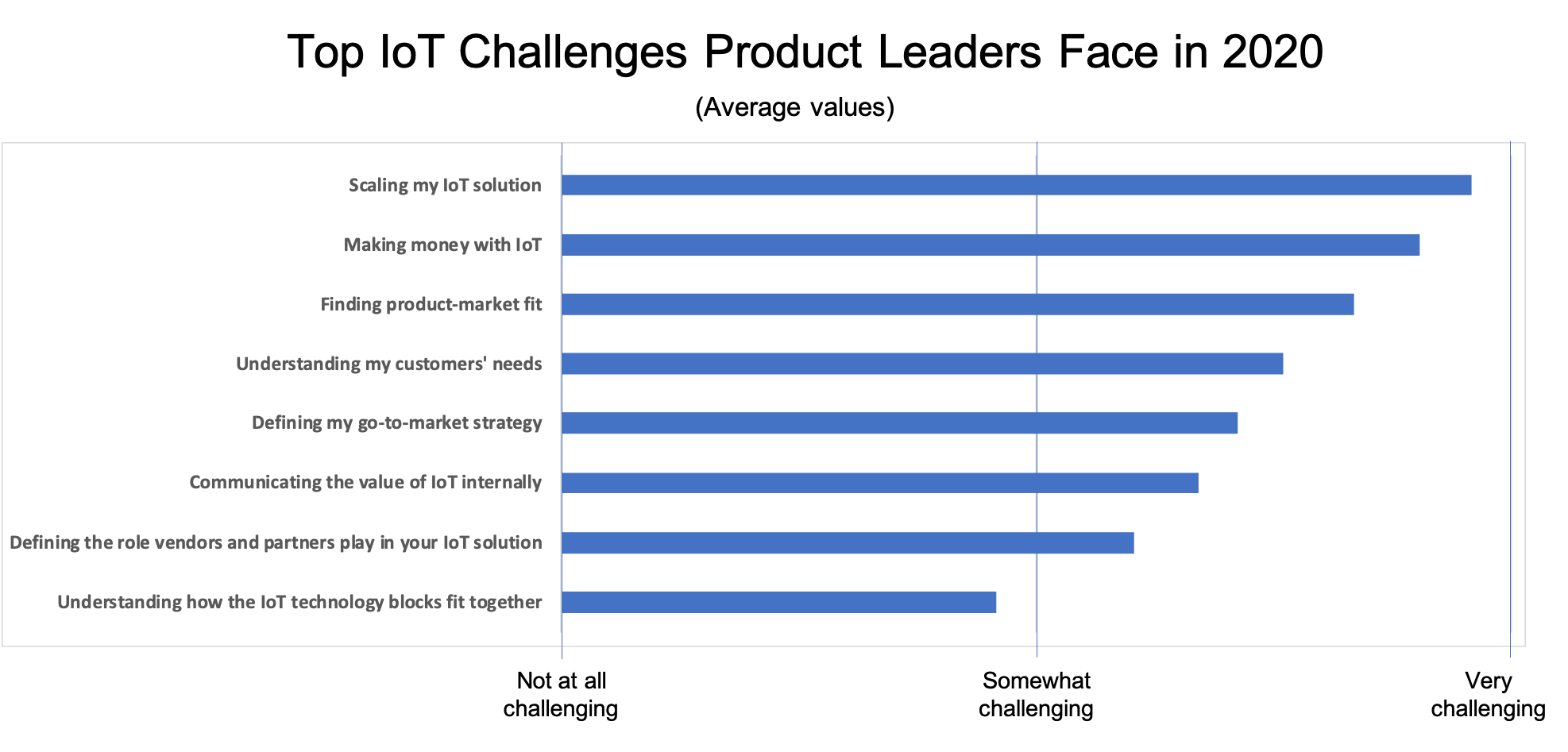
I received 73 responses to my survey. I understand this means the information is not statistically significant, but it does provide a good qualitative pulse on the top IoT challenges PMs are struggling with today.
Approximately 55% of responses came from Managers and 45% from people in Leadership roles (Director and above). Regarding company size, I received an almost even split between startups (less than 100 people), mid-size companies (101-10,000 people), and large corporations (10,000+ people).
What are the Top IoT Challenges PMs face in 2020?
The chart below shows the average responses to the question, “What is your biggest IoT challenge today.”

As you can see, the top three challenges are:
- Scaling my IoT solution
- Making money with IoT
- Finding product-market fit
Interestingly, the top three challenges were consistent across all demographics. Both small and large companies ranked these as their top IoT challenges. The same was true from PMs to CEOs. Everyone seems to be struggling with the same issues.
On the other hand, I was happy to see that “understanding how the IoT technology building blocks fit together” was last on the list. A few years back, most companies were struggling to grasp the basics of the IoT Technology Stack and figure out how to put together a solution. Today, it seems we are past that hurdle, and the IoT challenges towards adoption are mostly business-related.
Let’s look at the top three IoT challenges in more detail.
Note: I’ll be writing in-depth articles on each of these challenges. Make sure you subscribe to my newsletter, so you don’t miss out!
1- Scaling my IoT Solution
I have to admit, having scalability ranked as the #1 IoT challenge surprised me. I didn’t expect that.
On the other hand, this as a positive sign of where the industry is today. Five years ago, the top IoT challenge was building the solution or getting your first customers. Now it seems that companies are getting better traction with early adopters and are now ready to scale.
To do so, you need to have product-market fit—meaning a lack of scalability might be just a symptom of the overall problem and not the cause. On the other hand, more than half of respondents with scalability issues didn’t mark product-market fit as a challenge.
Instead, here are some of the reasons respondents gave for the scalability challenge:
- Lack of an enterprise sales team that can secure new deals
- Misalignment with marketing in communicating the value of our solution to customers
- Industrial IoT deployments take too long
- Every customer is different, so there’s a need for constant customization
- An emphasis on security (Although it’s a good thing, it’s slowing us down)
- Lack of standards (mainly connectivity) make it hard to scale globally without additional engineering efforts
[My biggest challenge is to] convince large enterprise customers to try and start the PoC quickly.
-Director at a startup
[My biggest challenge is] the fact that every customer seems to be a snowflake.
-VP at a startup
2- Making money with IoT
Making money with IoT continues to be a challenge for companies of all sizes. Although it was #2 on the list for both startups and big companies, I saw more urgency from startups than large companies.
I understand why. Startups have a short runway, and if they can’t make money soon, they’ll go out of business. That is usually not true with big companies.
But the lack of urgency from big companies is concerning. Place these initiatives on the back burner for too long, and you risk being disrupted.
Here are some of the causes respondents provided for the “making money” challenge:
- Unable to scale and therefore not able to gain economies of scale
- Cost of building an IoT solution is too high
- Finding the right business model
- Customer’s willingness to pay is small compared to the price of the solution
- Proof of concept or pilot takes too long, and it’s expensive to offer
The customer is usually sold on a dream and disappointed in the execution without being realistic.
-Manager at a large company
3- Finding product-market fit
Finding product-market fit is the core responsibility of any Product Leader. As seen in this survey, it’s still one of the biggest challenges we face in IoT.
Some of the survey responses indicate that companies are still looking at IoT as a horizontal solution across many verticals as opposed to focusing on specific industries. This is more common in large companies than in startups, but the challenge is still visible across all company sizes.
Some of the respondents’ challenges around product-market fit include:
- Need for deep customization for each customer
- Difficulty explaining the value of the IoT solution to the customer
- Difficulty mapping the ecosystem of partners
Additional Challenges
The survey included several open-ended questions with the goal of learning, in the words of actual Product Leaders, the other challenges they currently face. Many of the answers supported the top three challenges listed above. Additionally, a few other topics continuously came up. Here are those topics, in no particular order.
IoT security
Security was a popular response, mentioned as a challenge companies didn’t know how to tackle, as cost-prohibitive, or as having a negative impact on adoption due to customer trust. The IoT industry has made significant progress on this topic, but much more needs to be done.
Recommended article: How to Protect Your IoT Product from Hackers
IoT standards
The need for clear technology standards came up several times.. Whether because of connectivity needs, electric power discrepancies between countries, or even how “standards” change too quickly and make existing components obsolete, companies complain that it’s too difficult to put together a solution that works globally.
Understanding the impact standards have on your product strategy is vital. That’s why I included standards as a decision area in my IoT Decision Framework. The framework gives you and your team a structured way to plan for how standards and regulations will impact your IoT product.
[A big challenge is] navigating international standards and cellular agreements.
-Director at a mid-size company
Getting executive support
We see many companies jumping on the hype of IoT and directing their product teams to build “something with IoT.” I can understand the approach, but unless teams get full executive support to experiment and build an innovative solution, most likely this initiative will go nowhere.
In the survey, the lack of executive support had many forms, including:
- Lack of budget to grow the sales team
- No budget to hire engineers or data scientists
- Difficulty getting internal alignment
- Struggling to support the IoT initiative mid-to-long term
My biggest challenge is to move my slow organization forward, which is still in the mindset of the 80s.
-Manager at a large company
[My challenge is] enlarging the Digital Team with Sales/Business Development for better market penetration.
-Manager at a mid-size company
Building sustainable IoT products
As the Climate Crisis continues to advance, Product Leaders are looking to be part of the solution as opposed to the problem. In the past, I’ve talked about how IoT can help fight the Climate Crisis, but this time, I wanted to know if building sustainable solutions is a priority for Product Leaders.
I was happy to learn that the vast majority of respondents said that developing sustainable IoT solutions is very important to them. Many of them believe in the overall impact their product can have on the environment, and many others see sustainability as a business differentiator for their company and product.
The question now is not whether product sustainability is essential. Rather, it is how to achieve it. I’ll be writing on this topic very soon, so stay tuned!
The Bottom Line
The results from this survey are consistent with several other studies I’ve read and resemble conversations I’ve had with hundreds of Product Leaders. I find that concerning. Remember how five to seven years ago the market predictions pointed to 2020 as the year where the promise of IoT would become a reality? Well, we are in 2020 now, I don’t think we are there yet.
It is true that technology has evolved tremendously, and that there are many examples of successful IoT implementation. But as a whole, IoT is still struggling to deliver the value it promised. The top challenges highlighted in the survey all revolve around adoption, growth, and ultimately financial results.
The Internet of Things can add tremendous value, and connected products are becoming the new normal. Therefore, it’s up to us, Product Leaders, to figure out a path forward, to be innovative, and to put together the right recipe to deliver value with IoT.
I’m counting on you!
5 Comments
-
Great article & data. I agree that in many cases we’re seeing people experimenting without the understanding of how they would scale the experiment and at the same time not having a full grasp of the business benefits. IoT practitioners, just as with any other technology practitioner, need to be able to articulate the business benefits of what they are proposing as the days of buying technology for technologies’ sake are well and truly behind us. Shiny new toys while great, don’t build a sustainable model!
-
Great study and thanks to Daniel for sharing these results. These issues appear to all be pointing to a technolgy push rather than market pull scenarios. IoT is after all just a tool to most end users and requires justification for change. Industrial companies are not into fads but steady results due to their maturity and management culture. This is not good news for IoT practitioners. Market pull becomes the only solution for scalabilty and product fit – they generate the cash flow and profitability engine to drive the rest. How to get to market pull on a wide spread basis? Thats the next step that will separate winners from also-rans.
-
Author
Thank you Thomas. I agree this is worrisome for IoT practitioners. I see too many companies having a technology-first approach. I believe the way to get the market pull is by understanding the customer’s pains and then leveraging IoT as a tool to solve those pains. This requires shifting the perspective of companies towards technology, and that is not easy to do. I’ll be writing a lot about this in the coming months, so stay tuned!
What is your advice for solving this issue? What have you seen work?
-
If only there were a silver bullet for technology push…Unfortunately, I have found myself in the tech-push scenario several times as a PM. It means shifting expectations and execution to increase the length of runway.
From the business development side, tech-push means really long sales cycles – i.e. customers cannot be sold, they will have to be cultivated. If the resources are available, then co-development with carefully selected customers is one strategy to bootstrap sales – this can work but must be wisely chosen.
From the product development side, tech-push drives the need for a defensive posture, such as identifying key suppliers to partner with rather than trying to go it alone. This spreads the risk and lengthens the runway, but reduces revenue – 40% of something is better than 100% of nothing. These are just few examples of common PM techniques for dealing with tech-push problems until the market turns for you.
-
-